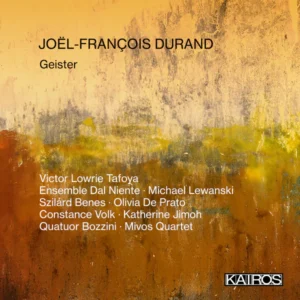Joël-François Durand – Geister (CD Review)
Joël-François Durand
Geister
Kairos Music
Olivia De Prato, violin; Victor Lowrie Tafoya, viola;
Constance Volk, flute; Szilárd Benes and Katherine Jimoh, clarinet
Mivos Quartet, Quatuor Bozzini
Ensemble Dal Niente, Michael Lewanski, conductor
On Geister, a double-CD release on Kairos, the music of Joël-François Durand receives benchmark performances by some of the best performers in contemporary classical music today. It features works from 2005-2022. Originally from France and currently based in the United States, Durand is Professor of Composition and Director of the School of Music at the University of Washington.
Over the course of his career, Durand has increasingly used microtones in his works. Since 2019, he has added the technique “beating,” in which two pitches are placed very close together, creating strong fluctuations. Another signature aspect of his style is intricate development of linear material.
His First String Quartet (2005), played here with fastidious detail by the Mivos Quartet, predates this investigation, but its use of simultaneous pizzicato and arco attacks, microtonal duets, and altered bowing, makes for an intricate musical surface. Written in the same year is In the Mirror Land, a duet played by Constance Volk, flute, and Katherine Jimoh, clarinet. The technique of shadowing, with the clarinet slowly emerging from its overlapping into the background, is important to the piece. Then the duo supply heterophonic overdubs of strident lines. La descente de l’ange (2022), for violin and clarinet, played by violinist Olivia De Prato and clarinetist Szilárd Benes, addresses similar concerns, but with its own distinct formal trajectory.
De Prato also provides a tour de force performance of the solo work In a Weightless Quiet (2020). At twelve minutes long, the intensity of the piece’s energy never flags.The use of open strings in the aforementioned beating technique appears at structural points in the piece. Then fortissimo fast repeated notes and bowed glissandos are juxtaposed against the beating, harmonics. and multi-stops. It finishes with altissimo secundal passages, double stops, and harmonics – a difficult piece delivered with élan.
Ensemble dal Niente, conducted by Michael Lewanski, performs Mundus Imaginalis (2015), the largest of the works programmed. Bass drum and a clattering metallic ostinato supply a syncopated groove. Lines overlap, at times contrapuntally, at others doubling to create reinforced textures. The tempo fluctuates, and semitones suggest cadences, only to be canceled swiftly by dissonant verticals. The incorporation of microtones intensifies as the piece progresses. Forte lower brass and chimes are added as it reaches its climax. Then a gradual denouement with a slowing of the percussive groove, chimes, colorful chords, repeated notes in the harp, and sustained wind solos that disassemble the opening material. Overtone verticals provide the piece with a stirring conclusion.
Geister, schwebende Geister … (2020) is a highlight. It also uses off-kilter percussion, corruscating melodic intervals, and open strings against small intervals to create beating and copious glissandos. Soloist Victor Lowrie Tafoya and Ensemble dal Niente, conducted by Lewaski, provide a fantastic performance that would serve as an excellent introduction for anyone curious about Durand’s music.
Cast in four movements, String Quartet No. 2 (2020), “Cantar de amigo,” played by Quatuor Bozzini, once again begins by bringing together previously mentioned techniques: the pulsation of tight beating intervals, sharp attacks, and bent sustained notes. Another texture prominent in the quartet is repeated notes set against glissandos. The tuning pitch, A = 440Hz., appears over and over, treated by all of the aforementioned techniques rather than settling into the in-tune version one would expect to hear before the beginning of an orchestra piece. The second movement begins to add harmonics above the A. The third movement puts hollow retorts of different notes below A, most relating to fifths above and below (E + D: other open strings found in the quartet in conventional tuning). The A bends this way and that, with microtonal glissandos distressing its centricity. With loud utterances, a high E starts to take prominence, only for A’s to cluster against it, and then low open strings weigh in as well. The only movement that begins attacca is the last, which at nine and a half minutes is of a significantly longer duration than those preceding. It begins once again with glissandos, but this time these start in the low strings, only gradually having all registers represented. In addition, some move in lower sliding figures, thus are higher up on the stringboard than the usual open sonorities. This creates a bit more of a covered sound. Midway through, octave A’s make a veritable cadence, only to be replaced by beating seconds in various registers. After a significant absence, a dash of repeated notes enter. Overlapping glissandos create a swath of blurred sonorities that persists throughout the middle section of the movement. Multi-octave A’s continue to announce each sectional division. As the piece progresses, glissandos ascend and descend into overlapping, mutable pitch schemes. High B cancels the penultimate octaves, leading to a final section in which the glissandos first grow smaller, prevailingly microtonal, and then wend their way towards A played pianissimo and cut off abruptly. String Quartet No. 2 is a combination of centricity, ambiguity, and extended harmony: a fascinating and successful work played with riveting poise and superlative attention to the smallest details by Quatuor Bozzini.
Geister is a collection to which I plan to regularly return to listen. It is one of my favorite recordings of 2024.
Christian Carey
